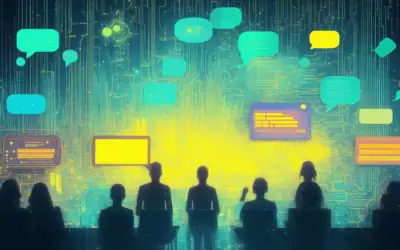Key Takeaways
- Transform Customer Engagement: Sales chatbots enhance customer interactions by providing immediate responses and personalized experiences, crucial for boosting satisfaction.
- 24/7 Availability: Unlike human agents, chatbots operate around the clock, ensuring customer inquiries are addressed anytime, leading to higher conversion rates.
- Lead Qualification Efficiency: By automating lead qualification, sales chatbots allow teams to focus on high-potential prospects, streamlining the sales process.
- Integration with CRM: Sales chatbots seamlessly connect with CRM systems, improving data tracking and customer relationship management.
- Cost Reduction: Automating repetitive tasks with chatbots can significantly lower operational costs, freeing up human resources for complex issues.
- Data-Driven Insights: Chatbots provide valuable analytics that help businesses understand customer behavior and refine sales strategies for better outcomes.
In today’s fast-paced digital landscape, businesses are increasingly turning to innovative solutions to enhance customer interactions and streamline sales processes. One such solution is the sales chatbot, a powerful tool that leverages chatbot artificial intelligence examples to engage customers effectively. This article delves into various sales chatbot examples across industries, showcasing how these intelligent systems are transforming retail and customer service. We will explore the fundamental question, what is a sales chatbot?, and examine the role of these chatbots in modern business. Additionally, we will highlight the benefits of implementing sales chatbots, provide diverse chatbot examples for customer engagement, and even take a closer look at notable case studies, such as Starbucks’ innovative chatbot implementation. Whether you’re interested in creating your own chatbot or simply curious about the latest trends in AI solutions, this comprehensive guide will equip you with valuable insights and practical knowledge to navigate the evolving world of chatbots for sales.
What is a sales chatbot?
A sales chatbot is an advanced automated software program specifically designed to enhance customer engagement and streamline the sales process. Utilizing artificial intelligence (AI) and natural language processing (NLP), sales chatbots can simulate human-like conversations, providing immediate responses to customer inquiries, delivering product information, and guiding potential buyers through the sales funnel.
Understanding the Role of Sales Chatbots in Modern Business
Sales chatbots play a crucial role in modern business by transforming how companies interact with customers. They are designed to improve efficiency, reduce response times, and enhance the overall customer experience. By integrating chatbot artificial intelligence examples into sales strategies, businesses can automate various tasks, allowing human agents to focus on more complex issues.
Chatbot Artificial Intelligence Examples in Sales
- 24/7 Availability: Unlike human sales representatives, chatbots can operate around the clock, ensuring that customer queries are addressed at any time, which can significantly improve customer satisfaction and conversion rates.
- Personalized Interactions: By leveraging customer data and previous interactions, sales chatbots can tailor conversations to individual preferences, enhancing the user experience and increasing the likelihood of a sale.
- Lead Qualification: Sales chatbots can efficiently qualify leads by asking targeted questions and gathering essential information, allowing sales teams to focus on high-potential prospects.
- Integration with CRM Systems: Many sales chatbots can be integrated with Customer Relationship Management (CRM) systems, enabling seamless data transfer and better tracking of customer interactions.
- Analytics and Reporting: Sales chatbots provide valuable insights through analytics, helping businesses understand customer behavior and preferences, which can inform future sales strategies.
Benefits of Implementing Sales Chatbots
Incorporating platforms like Messenger Bot can further enhance the reach and effectiveness of sales chatbots, as they allow businesses to engage with customers directly on popular messaging apps, increasing accessibility and convenience for users. Recent studies indicate that businesses utilizing sales chatbots can experience up to a 30% increase in sales conversions (source: Gartner). Furthermore, chatbots can reduce operational costs by automating repetitive tasks, allowing human agents to concentrate on more complex customer needs (source: McKinsey).
Overall, sales chatbots represent a powerful tool in modern sales strategies, driving efficiency and improving customer engagement through intelligent automation.
Understanding the Role of Sales Chatbots in Modern Business
Sales chatbots are transforming the way businesses interact with customers, providing a seamless blend of automation and personalized service. These intelligent systems not only enhance customer engagement but also streamline sales processes, making them an essential tool for modern businesses. By leveraging chatbot artificial intelligence examples, companies can improve their operational efficiency and customer satisfaction.
Chatbot Artificial Intelligence Examples in Sales
A chatbot is an automated software application designed to simulate human conversation through text or voice interactions. These intelligent systems utilize natural language processing (NLP) and machine learning to understand user inquiries and provide relevant responses. Key examples of chatbots include:
- Customer Service Bots: Many businesses deploy chatbots on their websites and social media platforms, such as Facebook Messenger, to assist customers with inquiries, provide support, and facilitate transactions. For instance, Sephora’s chatbot helps users find products and offers personalized beauty advice.
- Virtual Assistants: Prominent examples include Amazon’s Alexa and Apple’s Siri, which serve as personal assistants capable of performing tasks, answering questions, and controlling smart home devices through voice commands.
- E-commerce Bots: Chatbots like H&M’s virtual assistant guide users through shopping experiences, helping them find items and offering style recommendations based on user preferences.
- Healthcare Bots: Bots such as Buoy Health provide users with medical advice by asking a series of questions and suggesting possible conditions or next steps based on the responses.
The advantages of chatbots include 24/7 availability, reduced operational costs, and enhanced customer engagement. However, challenges such as understanding complex queries and maintaining a human-like interaction remain. For further insights into the effectiveness and implementation of chatbots, refer to studies from sources like the Journal of Business Research and reports from Gartner, which highlight the growing trend of chatbot adoption across various industries.
Benefits of Implementing Sales Chatbots
Integrating sales chatbots into your business strategy offers numerous benefits that can significantly enhance customer interactions and drive sales. Here are some key advantages:
- Increased Efficiency: Sales chatbots can handle multiple inquiries simultaneously, allowing businesses to manage customer interactions more effectively without the need for additional staff.
- Cost Savings: By automating routine tasks, companies can reduce operational costs associated with customer service and sales processes.
- Enhanced Customer Experience: Chatbots provide instant responses to customer inquiries, improving satisfaction and engagement. This is particularly important in today’s fast-paced digital environment.
- Lead Generation: Sales chatbots can qualify leads by engaging users in conversation, gathering information, and directing them to appropriate sales channels.
To explore how to implement a sales chatbot effectively, consider reviewing chatbot marketing examples and chatbot message examples that can inspire your design and strategy.
Exploring Retail Chatbot Examples for Enhanced Shopping Experiences
Retail chatbots have revolutionized the way consumers interact with brands, providing personalized experiences that enhance shopping efficiency. These sales chatbots leverage chatbot artificial intelligence examples to engage customers, streamline processes, and ultimately drive sales. By integrating these tools, retailers can offer tailored recommendations and support, significantly improving customer satisfaction.
Best Sales Chatbot Example for Retail
One prominent example of a retail chatbot is Sephora’s Virtual Artist, which operates on various messaging platforms, including Kik and Facebook Messenger. This innovative chatbot enhances the shopping experience by engaging users in an interactive quiz that assesses their beauty preferences and skin types. Based on the responses, Sephora’s Virtual Artist provides personalized product recommendations, helping customers discover makeup and skincare products tailored to their individual needs.
Additionally, another notable example is H&M’s chatbot, which assists users in finding clothing items based on their style preferences and current trends. This chatbot not only suggests outfits but also allows users to browse the latest collections directly through the chat interface, streamlining the shopping process. According to a report by Juniper Research, chatbots are expected to save retailers over $11 billion annually by 2023, highlighting their growing importance in the e-commerce landscape.
Customer Service Chatbot Examples in Retail
Customer service chatbots play a crucial role in enhancing the retail experience by providing instant support and personalized shopping experiences. For instance, the IBM Watson Assistant is a powerful tool that many retailers utilize to handle customer inquiries efficiently. This AI-driven solution can answer questions, guide users through product selections, and resolve issues without human intervention.
Another example is the Salesforce Service Cloud, which integrates chatbots to manage customer service interactions seamlessly. These customer service chatbot examples not only improve engagement but also drive sales by providing immediate assistance, thereby enhancing the overall shopping experience.
What is a Sale Bot?
A sale bot, often referred to as a sales chatbot, is an automated tool designed to facilitate sales processes through conversational interactions. These bots utilize chatbot artificial intelligence examples to engage with potential customers, answer inquiries, and guide them through the purchasing journey. By leveraging AI technology, sale bots can operate 24/7, providing immediate assistance and enhancing the overall customer experience.
Differences Between Sales Chatbots and Sale Bots
While the terms “sales chatbot” and “sale bot” are often used interchangeably, there are subtle differences between them. Sales chatbots are typically more focused on engaging customers in real-time conversations, answering questions, and providing personalized recommendations. In contrast, sale bots may encompass a broader range of functionalities, including automated follow-ups, lead generation, and nurturing prospects through the sales funnel.
- Sales Chatbots: Primarily designed for real-time interaction, these bots excel in customer engagement and support.
- Sale Bots: These bots may include additional features like automated marketing campaigns and lead scoring, making them versatile tools for sales teams.
AI Sales Bots: Revolutionizing Sales Processes
AI sales bots are transforming the way businesses approach sales by automating repetitive tasks and enhancing customer interactions. These bots can analyze customer data to provide insights and recommendations, making them invaluable for sales teams. For instance, they can identify potential leads based on user behavior and preferences, allowing sales representatives to focus on high-value prospects.
Moreover, AI sales bots can integrate with various platforms, enabling seamless communication across channels. This integration not only improves efficiency but also ensures that customers receive consistent support, whether they are interacting via a website, social media, or messaging apps. As businesses continue to adopt AI technologies, the role of sales chatbots and sale bots will only grow, driving innovation in customer engagement strategies.
For more insights on how to implement a sales chatbot effectively, explore our chatbot tutorials and discover the features that can enhance your sales processes.
What is a Sale Bot?
A sales bot is an advanced AI-driven software application that automates and enhances various facets of the sales process. Utilizing sophisticated technologies such as natural language processing (NLP) and machine learning, sales bots can effectively engage with potential customers, qualify leads, schedule appointments, and deliver personalized responses tailored to individual user needs.
Differences Between Sales Chatbots and Sale Bots
While both sales chatbots and sale bots serve the purpose of enhancing sales processes, they differ in functionality and application. Sales chatbots primarily focus on engaging customers through conversational interfaces, often found on websites and messaging platforms. They excel in providing real-time responses and support, making them ideal for customer service interactions.
On the other hand, sale bots encompass a broader range of functionalities, including lead qualification and appointment scheduling. They are designed to automate various sales tasks, allowing businesses to streamline their operations and improve efficiency. For instance, a sales bot can analyze user interactions to determine lead quality, while a sales chatbot may focus on answering customer inquiries.
AI Sales Bots: Revolutionizing Sales Processes
AI sales bots are transforming the sales landscape by providing businesses with tools that enhance customer engagement and streamline operations. Here are some key features that highlight their impact:
- Lead Engagement: Sales bots initiate conversations with potential customers through various platforms, including websites, social media, and messaging apps. This immediate engagement helps capture leads in real-time, increasing the chances of conversion.
- Lead Qualification: By analyzing user interactions and responses, sales bots can assess the quality of leads. They ask targeted questions to determine the prospect’s needs and readiness to purchase, allowing sales teams to focus on high-potential leads.
- Appointment Scheduling: Sales bots can seamlessly integrate with calendar applications to schedule meetings between prospects and sales representatives. This automation reduces the back-and-forth communication typically involved in setting appointments.
- Personalized Responses: Leveraging machine learning algorithms, sales bots can provide tailored responses based on user behavior and preferences. This personalization enhances the customer experience and fosters stronger relationships.
- Data Collection and Analysis: Sales bots gather valuable data from interactions, which can be analyzed to improve sales strategies and customer insights. This data-driven approach enables businesses to refine their marketing efforts and better understand customer needs.
Recent studies indicate that businesses using sales bots experience a significant increase in lead conversion rates and customer satisfaction. According to a report by Gartner, by 2025, 75% of customer service interactions will be powered by AI, highlighting the growing importance of sales bots in modern sales strategies.
How to Create a Chatbot?
Creating a chatbot involves several key steps that ensure its effectiveness and user engagement. Here’s a comprehensive guide to building your first AI chatbot:
- Define the Purpose: Clearly outline what you want your chatbot to achieve. This could range from customer service support to providing information or facilitating transactions.
- Choose a Platform: Select a platform that suits your needs. Popular options include Dialogflow, Microsoft Bot Framework, and Chatfuel. Each platform offers unique features and integrations.
- Design the Conversation Flow: Map out the conversation paths your chatbot will take. Use flowcharts to visualize interactions, ensuring that the bot can handle various user inputs and guide them effectively.
- Develop the Chatbot:
- Set Up Your Chatbot: Use your website URL to integrate the chatbot into your site. Follow the platform’s instructions for setup.
- Train Your Chatbot: Input sample questions and responses to help the bot learn. Utilize natural language processing (NLP) to enhance understanding.
- Tune Your Chatbot: Continuously refine responses based on user interactions and feedback.
- Test Your Chatbot: Conduct thorough testing to identify any issues. Use testing tools provided by the platform to simulate user interactions and ensure the chatbot responds accurately.
- Create and Configure Your Chat Widget: Customize the appearance of your chat widget to match your website’s branding. Set up greetings and initial prompts to engage users effectively.
- Preview and Publish: Before going live, preview the chatbot to ensure everything functions as intended. Once satisfied, publish your chatbot on your website.
- Monitor and Optimize Performance: After launch, regularly analyze user interactions and feedback. Use analytics tools to track performance metrics and make necessary adjustments to improve user experience.
By following these steps, you can create a robust chatbot that enhances user engagement and meets your business objectives. For further reading on chatbot development, consider resources from the Brain Pod AI Help Center, which provide insights into the latest trends and methodologies in chatbot technology.
Chatbot Marketing Examples to Inspire Your Design
When designing your chatbot, looking at successful chatbot examples can provide valuable insights. Here are some effective chatbot marketing examples that can inspire your design:
- Sephora’s Virtual Artist: This chatbot allows users to try on makeup virtually, enhancing the shopping experience and driving sales.
- Duolingo’s Chatbot: It engages users in language practice through conversation, making learning interactive and fun.
- H&M’s Shopping Assistant: This chatbot helps users find clothing based on their preferences, streamlining the shopping process.
These examples illustrate how chatbots can enhance user engagement and drive sales. For more inspiration, explore chatbot features that can be integrated into your design.
Chatbot Examples for Students
Chatbots have become increasingly popular in educational settings, providing innovative solutions that enhance learning experiences for students. By leveraging chatbot artificial intelligence examples, educational institutions can create engaging and interactive environments that cater to diverse learning needs. Below, we explore specific sales chatbot examples tailored for students and how they can transform educational interactions.
Sales Chatbot Example for Students
A prime example of a sales chatbot designed for students is the AI Chat Assistant from Brain Pod AI. This chatbot is specifically tailored to assist students in navigating academic resources, answering queries about course offerings, and providing information on enrollment processes. By utilizing natural language processing, the chatbot can engage students in meaningful conversations, making it easier for them to find the information they need quickly.
Additionally, platforms like IBM Watson Assistant offer customizable chatbot solutions that can be integrated into educational websites. These chatbots can handle inquiries related to tuition fees, scholarship opportunities, and course schedules, ensuring that students receive timely and accurate information.
AI Chatbot Examples in Learning Environments
AI chatbots are revolutionizing learning environments by providing personalized support and enhancing student engagement. For instance, customer service chatbot examples in educational settings often include features that allow students to schedule appointments with academic advisors or access tutoring services. These chatbots streamline communication, reducing the workload on staff while ensuring students receive the assistance they require.
Moreover, chatbots can facilitate peer-to-peer interactions by connecting students with study groups or collaborative projects. This not only fosters a sense of community but also encourages collaborative learning, which is essential in today’s educational landscape. By implementing these chatbot examples, educational institutions can significantly improve student satisfaction and academic success.






